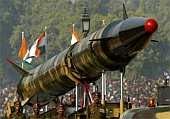 | « Back to article | Print this article |
 The Advanced Systems Laboratory (ASL) in Hyderabad, which develops India's strategic (long-range, nuclear-tipped) missiles, has dramatically increased the options for its forthcoming Agni-5 missile by making it highly road-mobile, or easily transportable by road.
The Advanced Systems Laboratory (ASL) in Hyderabad, which develops India's strategic (long-range, nuclear-tipped) missiles, has dramatically increased the options for its forthcoming Agni-5 missile by making it highly road-mobile, or easily transportable by road.
That enables the Agni-5 to reach targets far beyond its stated 5,000-km range by quickly moving closer to the target. In a hypothetical war against, say, Sweden, an Agni-5 launcher, stationed near Bangalore, would be unable to strike Stockholm, 7,000 km away. But moving by road to Amritsar would bring Stockholm within range.
Similarly, moving the Agni-5 to northeast India would bring even Harbin, China's northernmost city, within striking range. From various places across India, the Agni-5 can reach every continent except North and South America.
The Agni-5 will be the first canisterised, road-mobile missile in India's arsenal, similar to the Dongfeng-31A that created ripples during China's National Day Military Parade in Beijing on October 1. India's current long-range missile, the Agni-3, a non-canisterised missile, can only be moved with difficulty from one place to another.
In many other respects, the Agni-5, which is scheduled to make its first flight in early-2011, carries forward the Agni-3 pedigree. With composites used extensively to reduce weight, and a third stage added on (the Agni-3 was a two-stage missile), the Agni-5 can fly 1,500 km further than the 3,500-km Agni-3.
"The Agni-5 is specially tailored for road-mobility," explains Avinash Chander, Director, ASL. "With the canister having been successfully developed, all India's future land-based strategic missiles will be canisterised as well".
Made of maraging steel, a canister must provide a hermitically sealed atmosphere that preserves the missile for years. During firing, the canister must absorb enormous stresses when a thrust of 300to 400 tonnes is generated to eject the 50-tonne missile.
Canister technology was first developed in India for the Brahmos cruise missile. But it was the K-15 underwater-launched missile, developed here in Hyderabad for India's nuclear-powered submarine, INS Arihant, which fully overcame the technological hurdles in canisterising ballistic missiles.
Another major technological breakthrough that will beef up the Agni-5 is ASL's success in developing and testing MIRVs (multiple independently targetable re-entry vehicles). An MIRV, atop an Agni-5 missile, comprises three to 10 separate nuclear warheads. Each warhead can be assigned to a separate target, separated by hundreds of kilometres; alternatively, two or more warheads can be assigned to one target.
"We have made major progress on the MIRVs in the last two years," is all that Avinash Chander is willing to say on the subject.
Nevertheless, extensive testing still lies ahead for this highly complex technology. MIRVs will be deployed on the Agni-5 only after another 4-5 years.
While MIRV technology is similar to launching multiple satellites through a space rocket, a missile requires far greater accuracy. A satellite would be considered in correct orbit even it is a kilometre higher or lower than planned.
But each warhead in an MIRV must impact within 40 metres of its target. With such high accuracies, even small nuclear warheads are sufficient for the job.
Strategic planners consider MIRVs essential, given India's declared "no first use" nuclear policy. Even after an enemy has hit India with a full-fledged nuclear strike, destroying or incapacitating much of the strategic arsenal, a handful of surviving Indian missiles must be capable of retaliating with massive and unacceptable damage. Multiple warheads on a handful of Agni-5 missiles would constitute such a capability.
MIRVs also enable a single missile to overwhelm the enemy's missile defences. Tracking and shooting down multiple warheads are far more difficult than intercepting a single warhead.
Providing each warhead with the capability to maneuver, and dodge enemy interceptor missiles, increases survivability further. The MIRV warheads are also being given electronic packages for jamming enemy radars.